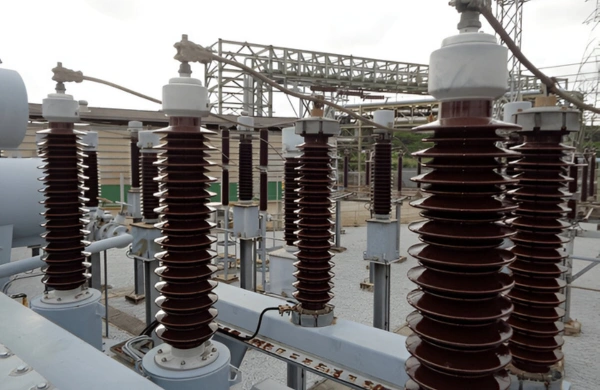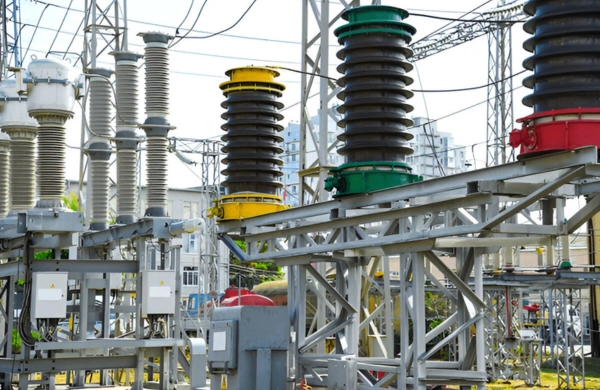Introduction
In every high-voltage transformer, the point where electrical energy enters or exits the tank is one of the most critical—and most vulnerable—interfaces. These entry points are managed by transformer bushings, which provide both electrical insulation and mechanical support between live conductors and the grounded transformer tank.
A bushing failure can lead to catastrophic consequences, including transformer outages, dielectric breakdowns, or even fire. Therefore, the reliability of a high-voltage transformer heavily depends on the design, material, and manufacturing quality of its bushings.
This article explores the engineering behind transformer bushings, the materials used, the testing standards that ensure long-term performance, and how Zetwerk supplies precision-engineered bushings and insulation assemblies for high-voltage transformers used across North America.
Know About Transformer Bushings: Critical to High-Voltage Performance
1. What Are Transformer Bushings?
A transformer bushing allows a conductor to pass safely through a grounded enclosure—such as the transformer tank—while maintaining electrical insulation and mechanical integrity.
In essence, it performs three vital functions:
- Electrical Insulation: Prevents current leakage between the conductor and grounded metal surfaces.
- Mechanical Support: Holds the conductor rigidly in place under mechanical stress, wind load, or vibration.
- Sealing: Prevents ingress of moisture or transformer oil leakage from the tank.
Bushings are installed on both the high-voltage and low-voltage sides of power and distribution transformers, and their performance directly impacts transformer safety and lifespan.
2. Types of Transformer Bushings
Transformer bushings are classified based on their insulation type and application voltage level.
a. Porcelain Bushings
Traditional and widely used, porcelain bushings are made from glazed ceramic material that provides excellent mechanical and dielectric strength.
- Suitable for voltages up to 245 kV
- Resistant to weathering and UV radiation
- Common in outdoor substations and distribution transformers
b. Resin-Impregnated Paper (RIP) Bushings
RIP bushings use layers of crepe paper impregnated with epoxy resin, cured under vacuum. They have a solid insulation body and no oil, making them maintenance-free and environmentally safer.
- Ideal for voltages up to 800 kV
- Non-flammable and partial-discharge resistant
- Compact and lightweight
c. Oil-Impregnated Paper (OIP) Bushings
OIP bushings are filled with oil to improve dielectric properties and heat dissipation. They are preferred for very high-voltage transformers and have proven long-term reliability.
- Suitable for voltages up to 1,200 kV
- Stable dielectric properties under heavy load
- Require regular oil monitoring
d. Polymer or Composite Bushings
These use silicone rubber or epoxy composites as insulation, offering lightweight construction and hydrophobic surfaces that resist pollution and flashover.
- Suitable for outdoor and coastal environments
- Excellent mechanical flexibility
- Resistant to tracking and contamination
Zetwerk designs and supplies both traditional and composite bushings based on specific system voltages, insulation requirements, and operating environments.
3. Materials and Construction
The performance of a transformer bushing depends on the precision of its materials and design.
Core Conductor:
Made of copper or aluminum, designed for high conductivity and minimal eddy losses.
Insulating Body:
- Porcelain or Silicone Rubber: Provides the primary dielectric barrier.
- Epoxy or Resin Layers: Used for solid insulation in RIP designs.
- Oil or Gas Insulation: Used in OIP or SF₆ designs for high-voltage bushings.
Capacitance Grading:
Bushings operating at higher voltages incorporate capacitive grading layers—alternating conductive and insulating layers—to evenly distribute the electric field and prevent localized stress.
Sealing and Flange Assembly:
Metal flanges, gaskets, and oil seals ensure leak-proof mounting to the transformer tank and safe pressure equalization during operation.
Zetwerk uses precision casting, curing, and machining to ensure dimensional accuracy and flawless surface finish, critical for minimizing corona discharge and partial discharges at high voltage.
4. Electrical and Mechanical Performance Parameters
Performance of transformer bushings is defined by several key parameters:
| Parameter | Typical Range / Property | Purpose |
| Voltage Rating | Up to 1,200 kV | Determines insulation design |
| Dielectric Strength | 10–20 kV/mm | Defines insulation breakdown resistance |
| Partial Discharge Inception Level | <5 pC | Ensures insulation integrity |
| Creepage Distance | 25–35 mm/kV | Prevents surface flashover |
| Thermal Class | Class A–H | Determines heat resistance |
| Mechanical Load | 5–10 kN | Resists wind and vibration stress |
By optimizing these factors, manufacturers ensure that bushings can endure decades of service under thermal, electrical, and environmental stress.
5. Testing and Quality Standards
Transformer bushings are tested to international standards to guarantee safe and reliable operation in high-voltage systems.
Electrical Tests
- Power Frequency Withstand Test
- Lightning Impulse Test
- Partial Discharge Measurement
- Capacitance and Tan-Delta Tests
Mechanical Tests
- Cantilever Load Test
- Thermal Cycling Test
- Sealing and Leak Tightness Test
Standards Followed
- IEC 60137 – Bushings for alternating voltages above 1 kV
- IEEE C57.19 – Standard for transformer bushings
- ANSI C29 Series – Insulator and bushing performance standards
Zetwerk’s manufacturing and test facilities comply with these standards, ensuring every bushing meets stringent electrical and mechanical benchmarks for utility and industrial applications.
6. Applications in High-Voltage Systems
Transformer bushings are integral to numerous industrial and grid operations:
- Power Transformers: High-voltage bushings for 110–800 kV grid applications.
- Distribution Transformers: Compact bushings for medium-voltage feeders.
- Switchgear and Circuit Breakers: Interface bushings for power connections.
- Generators and Reactors: Provide insulation for high-current outputs.
- Renewable Energy Systems: Used in step-up transformers for solar and wind installations.
With increasing renewable integration, transformer bushings now operate in harsher conditions—requiring advanced insulation systems and pollution-resistant materials that Zetwerk provides through its custom manufacturing.
7. Leading Transformer Bushing Manufacturers
1. Zetwerk Manufacturing USA
Delivers precision-engineered porcelain, polymer, and RIP bushings for power and distribution transformers. Zetwerk provides full manufacturing control—from material casting to final testing—ensuring UL, IEC, and IEEE compliance for North American utilities and OEMs.
2. ABB Power Components
Produces OIP and RIP bushings for high-voltage power transformers up to 1,200 kV.
3. GE Grid Solutions
Offers advanced hybrid composite bushings with integrated monitoring sensors for predictive maintenance.
4. PPC Insulators
Specializes in high-mechanical-strength porcelain bushings for utility and substation use.
5. Siemens Energy
Provides RIP and OIP bushings for transformers and reactors with advanced field grading technology.
8. Emerging Trends in Transformer Bushing Technology
The industry is evolving with innovations that improve performance, sustainability, and monitoring:
- Dry-Type RIP Designs: Replace oil with solid epoxy, reducing environmental impact.
- Integrated Condition Monitoring: Sensors embedded in bushings for real-time diagnostics.
- Silicone Composite Housings: Lighter, self-cleaning, and hydrophobic surfaces for outdoor reliability.
- Digital Twin Simulation: Used in design to predict thermal and electrical aging performance.
- Eco-Optimized Materials: Lead-free ceramics and recyclable polymer insulators.
Zetwerk’s manufacturing integrates these trends to meet the growing demand for safer, lighter, and maintenance-free transformer components.
Conclusion
Transformer bushings are the gatekeepers of electrical safety and efficiency in high-voltage transformers. They combine insulation, mechanical stability, and sealing functions in one critical component that directly affects transformer life and grid reliability.
With decades of material and electrical engineering expertise, Zetwerk manufactures precision-engineered transformer bushings designed for the most demanding industrial and utility environments. From porcelain and epoxy-molded units to next-generation composite designs, Zetwerk ensures UL/IEC compliance, proven dielectric performance, and on-time delivery for transformer manufacturers in North America.




FAQs
a. It provides insulated passage for a conductor through the transformer tank, ensuring electrical safety and mechanical stability.
a. Common causes include partial discharges, oil leakage, contamination, or aging of insulation materials.
a. RIP bushings use solid epoxy insulation, while OIP bushings are filled with oil for higher dielectric strength.
a. They undergo dielectric, partial discharge, and mechanical load tests as per IEC and IEEE standards.
a. Yes. Zetwerk provides tailored voltage ratings, insulation types, and mounting configurations for OEMs and utilities.








